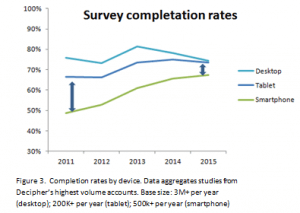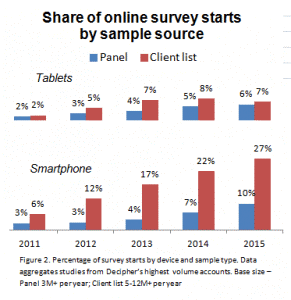Conference
Top 3 Trends in Mobile Surveys

By: Aaron Jue,
FocusVision
FocusVision
Each year, we analyze the millions of surveys hosted on our
online survey platform, Decipher, to get insights into respondent survey-taking
behaviors and investigate the latest mobile survey trends including these three
key trends market researchers need to know.
online survey platform, Decipher, to get insights into respondent survey-taking
behaviors and investigate the latest mobile survey trends including these three
key trends market researchers need to know.
Trend #1: Online survey starts from smartphone devices continue to grow
Mobile devices represent close to 30% of all survey starts
(Figure 1). The mobile growth trend in online surveys follows the overall
global trend of device usage. Industry analysts forecast smartphone
subscriptions from 2015 will double to 6.4 billion worldwide by 2021.[1]
(Figure 1). The mobile growth trend in online surveys follows the overall
global trend of device usage. Industry analysts forecast smartphone
subscriptions from 2015 will double to 6.4 billion worldwide by 2021.[1]
As smartphones increasingly replace the PC for primary
internet usage, we expect that the population of smartphone survey takers will
follow the same trend.
internet usage, we expect that the population of smartphone survey takers will
follow the same trend.
Trend
#2: Mobile friendly surveys = improved participation rates
#2: Mobile friendly surveys = improved participation rates
Mobile survey participation rates have steadily improved
while participation rates for desktop users have remained stable.
while participation rates for desktop users have remained stable.
This reflects Decipher client projects which, over the
years, have increasingly deployed mobile friendly surveys. We're constantly discussing best survey design
practices for mobile devices and these have been tested and put to good
use. By default all surveys hosted on
the Decipher platform employ a responsive survey design with options for many
dynamic and mobile friendly question types (e.g. card sort, buttons).
years, have increasingly deployed mobile friendly surveys. We're constantly discussing best survey design
practices for mobile devices and these have been tested and put to good
use. By default all surveys hosted on
the Decipher platform employ a responsive survey design with options for many
dynamic and mobile friendly question types (e.g. card sort, buttons).
Researchers are adjusting to the needs of the growing usage
for mobile devices, and survey designs have gotten better and smarter.
for mobile devices, and survey designs have gotten better and smarter.
Trend #3: Mobile penetration depends on sample source
The level of mobile participation for a given survey depends
on the sample characteristics. It is known, for instance that in the US,
minority groups, youths, and upper income individuals show higher incidence of
smartphone use.[2]
on the sample characteristics. It is known, for instance that in the US,
minority groups, youths, and upper income individuals show higher incidence of
smartphone use.[2]
Whether a survey employs panel sample or client supplied
sample (e.g. list of customers) has a tremendous impact as well.When a
client-supplied list is used, more than a quarter of respondents access the
survey using a smartphone; that number falls to 10% for panel respondents
(Figure 2).
sample (e.g. list of customers) has a tremendous impact as well.When a
client-supplied list is used, more than a quarter of respondents access the
survey using a smartphone; that number falls to 10% for panel respondents
(Figure 2).
Panel supplied sample has always had far fewer smartphone
survey takers. We suspect that's because
this population expects to receive surveys, and will use a PC out of habit or
for the better survey-user experience (i.e. larger screen size, mouse /
keyboard input). But the number of mobile panel members is growing and has more
than doubled since 2013. Besides the
increasing reliance on smartphone devices to access the internet, the growing industry acceptance and
deployment of smartphone friendly survey designs are undoubtedly driving this
trend.
survey takers. We suspect that's because
this population expects to receive surveys, and will use a PC out of habit or
for the better survey-user experience (i.e. larger screen size, mouse /
keyboard input). But the number of mobile panel members is growing and has more
than doubled since 2013. Besides the
increasing reliance on smartphone devices to access the internet, the growing industry acceptance and
deployment of smartphone friendly survey designs are undoubtedly driving this
trend.
Things Market
Researchers MUST Consider in 2016
Researchers MUST Consider in 2016
As the mobile population continue to grow, it's becoming
increasingly clear that researchers must adhere to mobile friendly principles
for online surveys. We can no longer simply resize surveys designed for the PC
and serve them on a smartphone without any regard for the smaller screen. It
leaves respondents frustrated with tiny text, input buttons, or horizontal
scales partially cut off from view. A survey that is friendly and optimized
across all platforms drives better data and higher respondent participation.
increasingly clear that researchers must adhere to mobile friendly principles
for online surveys. We can no longer simply resize surveys designed for the PC
and serve them on a smartphone without any regard for the smaller screen. It
leaves respondents frustrated with tiny text, input buttons, or horizontal
scales partially cut off from view. A survey that is friendly and optimized
across all platforms drives better data and higher respondent participation.
About Aaron Jue, FocusVision Market Research Director
With more than 10
years of full-service online survey knowledge and research, Aaron keeps
FocusVision at the forefront of new market research trends and best survey
design practices to maximize response rates and data quality. His role is to
capture key internal business performance metrics and FV customer insights.
years of full-service online survey knowledge and research, Aaron keeps
FocusVision at the forefront of new market research trends and best survey
design practices to maximize response rates and data quality. His role is to
capture key internal business performance metrics and FV customer insights.




